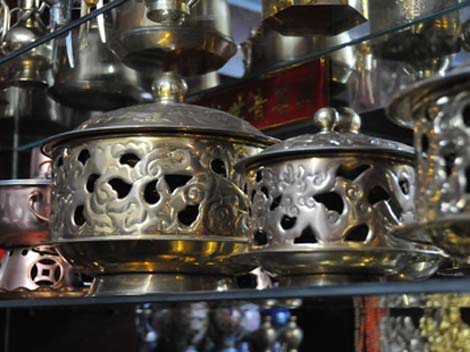
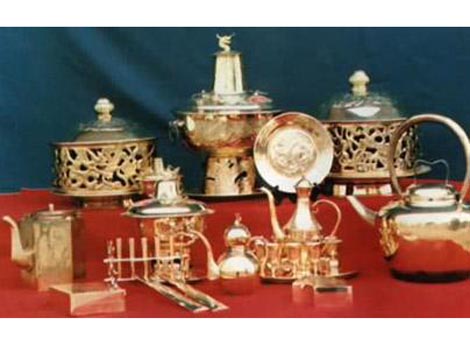
On the vast and bleak plateau north of the Great Wall in Shanxi Province is Datong, a historical city of China. With a history of more than 2,300 years, it has retained rich and brilliant cultural relics, including the Yungang Grottoes from the Northern Wei Dynasty, the wooden pagoda of Yingxian County dating from the Liao Dynasty, Huayan Monastery of the Liao and Jin periods and the Nine-Dragon Screen Wall from the Ming Dynasty. Folk arts have also blossomed here: sculpture, paper-cuts, clay sculpture, scorched painting, paper folding, wood carving, etc. Of these, the copper hotpot of Datong is special, being a famous traditional handicraft of Shanxi Province.

Located strategically on the northern frontier of ancient China, Datong is not only a famous cultural city with a long history but also one of the famous producers of folk copperware. In history is the saying: "Worship the Buddhas at Wutai Mountains and buy copperware in Datong. " As long as 2,000 years ago there was the industry of cast copper in Datong, which was first used in making weapons and later in making images of Buddhas and everyday articles. The copperware has the most exquisite workmanship and has enjoyed great fame since the Northern Wei Period. Since the Tang and Song dynasties, the copperware has had a ready market across China. By the Ming and Qing dynasties, copper casting and making copperware were already prosperous. Dozens of copperware workshops were in the courtyards and lanes of the Bell Tower area. They were family businesses handed down in generations; hence, the name "Street of Coppersmiths. "
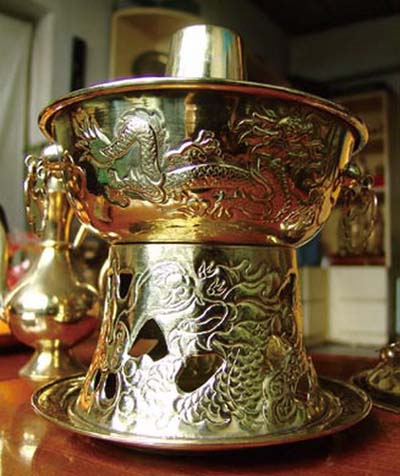
The hotpot of Datong consists of six parts: a base plate, a fire base, a pot, the lid of the pot, a copper chimney and the lid of the chimney
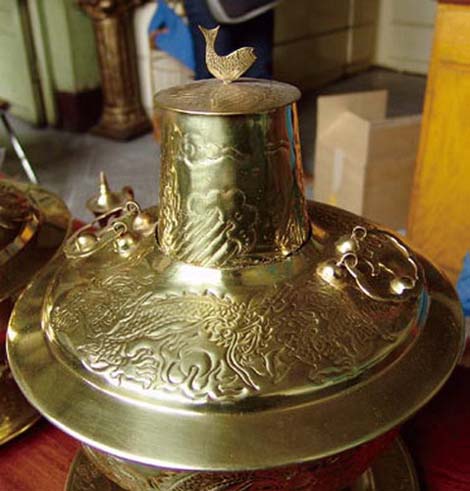
The meticulously engtaved decorative patterns on the lid of the hotpot
Of all the copperware, the hotpots are the most famous. These are tableware that cleverly combines the use of fire with a pot. Their appearance relates to the use of fire with a pot. Their appearance relates to the natural environment, which is cold. The hotpot can be used to prepare food and to heat the home. In addition, in ancient times this area was where the nomads grazed, and the tribes continued to migrate. Since copperware is both handy and durable, over time the hotpots have become a necessity for every household and a well-known local handicraft. Legend has it that the use of copper hotpots began in the early Ming Dynasty. They were invented by the local people to resist the cold. Later, they spread to the capital city of Beijing and were chosen for the imperial family's use. Another story goes that Zhu Gui (1374-1446), the 13th son of Zhu Yuanzhang (reigned 1368-1398), was fond of feasting but he became frustrated with the cold wines and dishes at the lengthy banquets in the cold winters. A clever official invented the hotpot by consolidating the wisdom of craftsmen he had assembled, using charcoal to heat the soup inside the pot. Having performed a meritorious service by presenting it to the emperor, the official was promoted by three levels immediately. Therefore, even today the local people call it the "pot of rapid promotion. "
The Datong hotpot has six parts: base plate, fire base, pot, lid of the pot, copper chimney and lid of the chimney. It is shaped like a tower about 12 inches high. Made of quality copper it is both beautiful and practical. The inside is coated with tin, which is rustproof and acts as a disinfectant, and retains the original taste of the food. The hotpot is most suitable for instant boiling of mutton slices, assorted vegetables and other food. Diners sitting around the hotpot enjoy the pleasure of placing the raw food inside and then retrieving them quickly to eat.
The production can be divided into six parts: formation, welding, lining with tin, chisel carving, polishing and assembling. The process requires skills of casting, designing and carving. The artisans of copper hotpots are noted for their casting skills. The designs of exquisite images on the pot are unique. The craftsmen meticulously carve and chisel on the bottom, body, and lid with such designs as dragon playing with phoenix (symbolizing love between man and woman), swallows flying through willows, fish accompanying lotus, magpies on plum trees, the Eight Immortals crossing the oceans (each showing his or her special prowess), and lions playing with embroidered balls. In addition, there are more than 200 decorative patterns, each of which is chiseled bit-by-bit with a small hammer and chisel. A copper hotpot with the design of the Eight Immortals is a representative work of a traditional theme of copper plate pictures. The tray, the stand, and the body of the hotpot are all made into octagons and the eight faces of the pot are engraved with the images of the Eight Immortals with different expressions. The pot bears an ancient simplicity and vigor, solemn and elegant, like a magnificent building of a fantasy wonderland. The copper hotpot has a bright and glistening form, gorgeous colors, strong ethnic traditions and styles, and unique local characteristics. It not only has practical value as a household untensil but also high aesthetic value, suitable as a home decoration and a gift for friends. In 1973, when Premier Zhou Enlai arrived in Datong accompanying Georges Pompidou (1911-1974), president of France, the local government presented the president with a copper hotpot engraved with the design of "Nine Dragons Ascending to the Moon. "
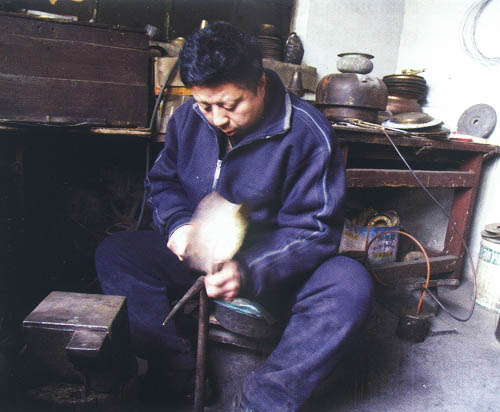
Making a copper hotpot
Eating from hotpots is enjoyable for the local people, where restaurants, big and small, serve hotpots, especially in winter when cold winds howl outside their windows.
Although the craftsmanship of copper hotpots happened long ago it has only a short written history of over 100 years. This is because Datong, a border city, has suffered the chaos of frequent wars, so the art of making copper hotpots was handed down only by oral teaching of mster to apprentice. No exact historical documents have recorded the styles, processes and methods of making hotpots.
However, this does not affect the wide use of the hotpot. Today, Datong restaurants, big and small, as well as in ordinary homes, enthusiastic diners sit around boiling copper hotpots and admire the delicacies year-round. The business becomes even brisker during freezing winters.




